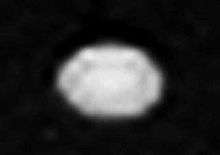Despina (moon)
Despina /dɛˈspaɪnə/, also known as Neptune V, is the third-closest inner satellite of Neptune. It is named after Greek mythological character Despoina, a nymph who was a daughter of Poseidon and Demeter.
 Despina as seen by Voyager 2 (smeared horizontally) | |
| Discovery | |
|---|---|
| Discovered by | Stephen P. Synnott[1] and Voyager Imaging Team |
| Discovery date | July 1989 |
| Designations | |
Designation | Neptune V |
| Pronunciation | /dɪˈspaɪnə, dɪˈspiːnə, dɛ-/ |
Named after | Δέσποινα Despœna |
| Adjectives | Despinian |
| Orbital characteristics[2][3] | |
| Epoch 18 August 1989 | |
| 52 525.95 km | |
| Eccentricity | 0.00038 ± 0.00016 |
| 0.33465551 ± 0.00000001 d | |
| Inclination |
|
| Satellite of | Neptune |
| Physical characteristics | |
| Dimensions | 180×148×128 km[4][5] |
Mean radius | 78.0 ± 4.7 km[3] |
| Volume | ~1.8×106 km³ |
| Mass | ~2.2×1018 kg (based on assumed density) |
Mean density | ~1.2 g/cm³ (estimate)[6] |
| ~0.026 m/s2[lower-alpha 1] | |
| ~0.063 km/s[lower-alpha 2] | |
| synchronous | |
| zero | |
| Albedo | 0.09[4][6] |
| Temperature | ~51 K mean (estimate) |
| 22.0[6] | |
Discovery
Despina was discovered in late July 1989 from the images taken by the Voyager 2 probe. It was given the temporary designation S/1989 N 3.[7] The discovery was announced (IAUC 4824) on 2 August 1989, and mentions "10 frames taken over 5 days", implying a discovery date of sometime before July 28. The name was given on 16 September 1991.[8]
Physical characteristics
Despina's diameter is approximately 152 kilometres (94 mi).[9]Despina is irregularly shaped and shows no sign of any geological modification. It is likely that it is a rubble pile re-accreted from fragments of Neptune's original satellites, which were disrupted by perturbations from Triton soon after that moon's capture into a very eccentric initial orbit.[10]
Orbit
Despina's orbit lies close to but outside of the orbit of Thalassa and just inside the Le Verrier ring. As it is also below Neptune's synchronous orbit radius, it is slowly spiralling inward due to tidal deceleration and may eventually impact Neptune's atmosphere, or break up into a planetary ring upon passing its Roche limit due to tidal stretching.
Notes
- Surface gravity derived from the mass m, the gravitational constant G and the radius r: Gm/r2.
- Escape velocity derived from the mass m, the gravitational constant G and the radius r: √2Gm/r.
References
- Planet Neptune Data http://www.princeton.edu/~willman/planetary_systems/Sol/Neptune/
- Jacobson, R. A.; Owen, W. M., Jr. (2004). "The orbits of the inner Neptunian satellites from Voyager, Earthbased, and Hubble Space Telescope observations". Astronomical Journal. 128 (3): 1412–1417. Bibcode:2004AJ....128.1412J. doi:10.1086/423037.CS1 maint: ref=harv (link)
- Showalter, M. R.; de Pater, I.; Lissauer, J. J.; French, R. S. (2019). "The seventh inner moon of Neptune" (PDF). Nature. 566 (7744): 350–353. Bibcode:2019Natur.566..350S. doi:10.1038/s41586-019-0909-9. PMC 6424524. PMID 30787452.
- Karkoschka, Erich (2003). "Sizes, shapes, and albedos of the inner satellites of Neptune". Icarus. 162 (2): 400–407. Bibcode:2003Icar..162..400K. doi:10.1016/S0019-1035(03)00002-2.CS1 maint: ref=harv (link)
- Williams, Dr. David R. (2008-01-22). "Neptunian Satellite Fact Sheet". NASA (National Space Science Data Center). Retrieved 2008-12-13.
- "Planetary Satellite Physical Parameters". JPL (Solar System Dynamics). 2008-10-24. Retrieved 2008-12-13.
- Marsden, Brian G. (August 2, 1989). "Satellites of Neptune". IAU Circular. 4824. Retrieved 2011-10-26.
- Marsden, Brian G. (September 16, 1991). "Satellites of Saturn and Neptune". IAU Circular. 5347. Retrieved 2011-10-26.
- "Where Are You From? - Credo Reference". search.credoreference.com. Retrieved 2017-02-12.
- Banfield, Don; Murray, Norm (October 1992). "A dynamical history of the inner Neptunian satellites". Icarus. 99 (2): 390–401. Bibcode:1992Icar...99..390B. doi:10.1016/0019-1035(92)90155-Z.CS1 maint: ref=harv (link)


_flatten_crop.jpg)